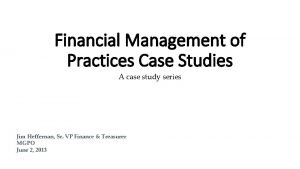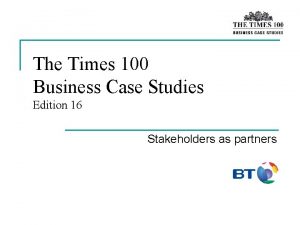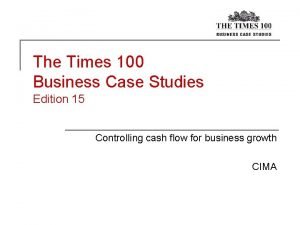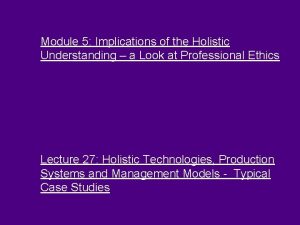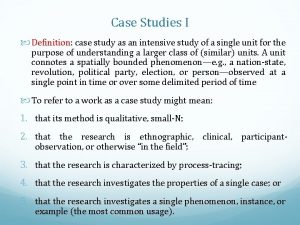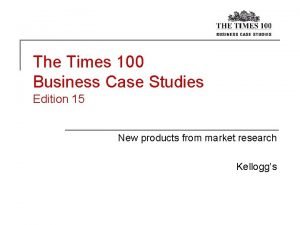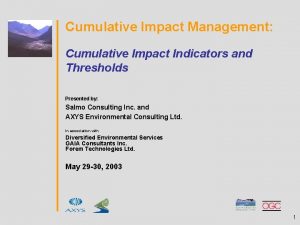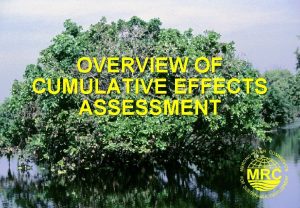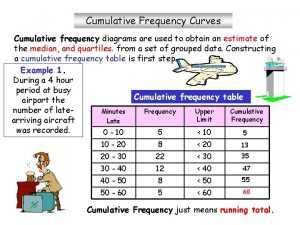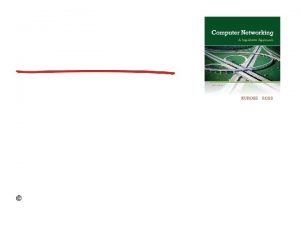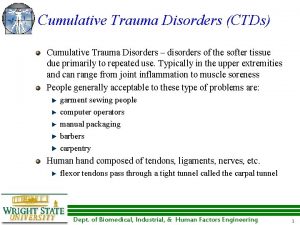Cumulative Impact Management Cumulative Effects Case Studies Presented






















- Slides: 22

Cumulative Impact Management: Cumulative Effects Case Studies Presented by: Salmo Consulting Inc. and AXYS Environmental Consulting Ltd. in association with Diversified Environmental Services GAIA Consultants Inc. Forem Technologies Ltd. May 29 -30, 2003 1

Introduction • A component of the Cumulative Impact Management (CIM) framework • Detailed evaluations in Blueberry and Sukunka Case Study areas – Document land use, fish and wildlife trends and identify apparent thresholds – Test CIM indicators – Evaluate utility of readily-available data – Simulate future resource trends – Identify implementation issues 2

Case Studies: Blueberry Area • 2, 690 km 2 area northeast of Wonowon • 50 year multi-sector development history • Boreal Plains • Beatton River watershed • Overlaps 4 RMZ in FSJ LRMP area – Jedney Enhanced Resource Mgmt – Agriculture/Settlement – Grazing Reserve – Alaska Highway Corridor 3

Case Studies: Blueberry Area Key Species Arctic grayling Present √ √ Bull trout Moose √√ Elk √ Caribou √ Deer √ Grizzly bear √ Marten √ Listed Warblers Absent √√ 4

Case Studies: Sukunka Area • 1, 200 km 2 area south of Chetwynd • 20+ year multi-sector development history • Rocky Mountain Foothills • Sukunka River watershed • Overlaps 6 RMZ in Dawson LRMP area – South Peace (Burnt River) Enhanced Resource Mgmt zone – Sukunka and Pine River Corridor Special Mgmt zones 5

Case Studies: Sukunka Area Key Species Present Arctic grayling √ Bull trout √ Moose √ Elk √ Caribou √ Deer √ Grizzly bear √√ Marten √√ Listed Warblers Absent √ 6

Case Studies: Methods • Developed GIS database – Forest cover • Government digital data – Land use • Government TRIM digital data • Historical air photos • Resource trends – Fish and wildlife surveys and reports – Wildlife harvest 7

Case Studies: Trends • Land Use – Access corridors (roads, trails, seismic lines, pipelines, power lines, rail lines) – Clearings (wells, facilities, cut blocks, agricultural, mines, residential) – Cumulative Impact Indicators (access density, stream crossing index) • Resource – Focus wildlife species • Moose, woodland caribou, elk, grizzly bear – Wildlife habitat suitability ratings • 4 class system based on forest cover and age – Cumulative Impact Indicators (core area, patch size) 8

Case Studies: Trends • Evaluated relationship between habitat and land use trends and wildlife population index (harvest success) • Future trends in Blueberry area – Forecast using existing ALCES model – 100 years: 1950 to 2050 9

Case Studies: Future Scenarios …. . • Forecast changes from natural processes – Natural disturbance regime (fire and natural succession) • Forecast changes from human disturbance – Land use trends extrapolated from past history • Low, Moderate, High growth scenarios • Simulation (what-if? ) modelling for combined changes – Wildlife habitat effectiveness – Variable effect management methods • Best Practices, 10

Blueberry Case Study: Clearing Trends …. . 11

Blueberry Case Study: Access Trends …. . 12

Blueberry Case Study: Moose Natural Disturbance …. . 1950 2000 2050 13

Blueberry Case Study: Moose Combined Disturbance …. . 1950 2000 2050 14

Blueberry Case Study: Moose Population Trends…. . • Moose harvest variable but generally declining – Harvest influenced by environmental factors, regulation changes, and improved access (OHVs) • Gradual decrease in harvest success – Success inversely related to level of disturbance – Success directly related to amount of core (undisturbed) habitat 15

Blueberry Case Study: Moose Population Trends…. . • Increased cumulative impact risk …. . – Most moose now inhabit ‘edge’ areas where disturbance and human mortality risk is higher – Steady, slow loss of habitat to permanent infrastructure • …. not translated into population declines – Population stable between 1982 and 1998 – Combined disturbance in range of natural variability – Restrictive harvest restrictions – Increased availability of early seral stages – Possibly reduced predation 16

Blueberry Case Study: Caribou Natural Disturbance …. . 1950 2000 2050 17

Blueberry Case Study: Caribou Combined Disturbance …. . 1950 2000 2050 18

Blueberry Case Study: Caribou Population Trends…. . • Population numbers low – Initially limited by natural fire patterns – Regional populations significantly lower than historical levels – Caribou presence ‘occasional’ by early 1980’s • Increased cumulative effects risk – Combined disturbance outside range of natural variability – Woodland caribou unlikely to persist in Blueberry study area 19

Understanding the Landscape: Case Study Findings • Readily-available data limited analyses • Access density and core area indicators both statistically related to moose and elk population indices – Predictive power equivalent to more detailed and costly habitat indicators – Increased cumulative effects risk not translated into population declines for these species • All indicators suggest that probability of woodland caribou persistence in Case Study areas is low – Both natural and human causes 20

Understanding the Landscape: Case Study Findings • ALCES simulations provide valuable historical and future insights • Published access density relationships may not apply directly to Northeast BC – No clear thresholds evident – Comparatively low population and human activity – Research in developed landscapes needed to document regional fish and wildlife response 21

22
 Ref impact case studies
Ref impact case studies What is cause and effect in text structure
What is cause and effect in text structure Cumulative effects theory
Cumulative effects theory Best worst and average case
Best worst and average case Financial management case study
Financial management case study Paradigm shift from women studies to gender studies
Paradigm shift from women studies to gender studies Advantages of case studies in psychology
Advantages of case studies in psychology Times 100 case studies
Times 100 case studies The times 100 business case studies
The times 100 business case studies Holistic technology in human values
Holistic technology in human values Advantages and disadvantages of case control studies
Advantages and disadvantages of case control studies Case series
Case series Eu-gdpr-p
Eu-gdpr-p Gcse geography manchester case study
Gcse geography manchester case study Daniel james euthanasia
Daniel james euthanasia E procurement case studies
E procurement case studies Types of case studies
Types of case studies Define: case study
Define: case study Times 100 case studies
Times 100 case studies Nasa system failure case studies
Nasa system failure case studies Abo discrepancy case studies with answers
Abo discrepancy case studies with answers Chemistry ethics case studies
Chemistry ethics case studies Nspe board of ethical review cases
Nspe board of ethical review cases




